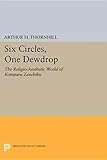Six Circles, One Dewdrop : The Religio-Aesthetic World of Komparu Zenchiku / Arthur H. Thornhill.
Material type: TextSeries: Princeton Legacy Library ; 5192Publisher: Princeton, NJ : Princeton University Press, [2017]Copyright date: ©1993Description: 1 online resource (252 p.)Content type:
TextSeries: Princeton Legacy Library ; 5192Publisher: Princeton, NJ : Princeton University Press, [2017]Copyright date: ©1993Description: 1 online resource (252 p.)Content type: - 9781400887187
- 895.6/22409 23
- PN2924.5.N6 T46 2017eb
- online - DeGruyter
| Item type | Current library | Call number | URL | Status | Notes | Barcode | |
|---|---|---|---|---|---|---|---|
 eBook
eBook
|
Biblioteca "Angelicum" Pont. Univ. S.Tommaso d'Aquino Nuvola online | online - DeGruyter (Browse shelf(Opens below)) | Online access | Not for loan (Accesso limitato) | Accesso per gli utenti autorizzati / Access for authorized users | (dgr)9781400887187 |
Frontmatter -- Contents -- List of Figures -- Preface -- Abbreviations -- Chapter One: Introduction -- Chapter Two: Translations -- Chapter Three: Six Circles of Performance -- Chapter Four: Shigyoku's Commentary —The Buddhist Response -- Chapter Five: Kaneyoshi's Commentary —The Confucian Response -- Chapter Six: Zenchiku and Medieval Shinto -- Chapter Seven: Conclusion -- Appendix: A Catalog of Zenchiku's Treatises -- Glossary -- Bibliography -- Index
restricted access online access with authorization star
http://purl.org/coar/access_right/c_16ec
Noh drama has long fascinated Westerners by its poetic excellence and its dramatic power. To the student of medieval Japanese culture, however, noh writings, especially dramaturgical treatises, are also of immense value as "monuments" of culture. To uncover the larger patterns of cultural discourse in these theoretical works, Arthur Thornhill presents the first major study in English of the dramaturgical treatises of Komparu Zenchiku (1405-1468?), son-in-law and pupil of the illustrious Zeami and a pivotal figure in the history of Japanese noh drama. The book begins with annotated translations of two of Zenchiku's most important treatises, which delineate a system of seven symbolic categories called "six circles and one dewdrop." Especially significant are two commentaries appended to the first treatise and composed by the Buddhist prelate Shigyoku (1383-1463) and Ichijo Kaneyoshi (1402-1481), the renowned court official and scholar of native literature and the Chinese classics. Together Zenchiku's symbolic system and the two commentaries reveal a microcosm of the intellectual and cultural dialogue among the dominant creeds of the Muromachi period--Buddhism, Confucianism, and Shinto.Originally published in 1993.The Princeton Legacy Library uses the latest print-on-demand technology to again make available previously out-of-print books from the distinguished backlist of Princeton University Press. These editions preserve the original texts of these important books while presenting them in durable paperback and hardcover editions. The goal of the Princeton Legacy Library is to vastly increase access to the rich scholarly heritage found in the thousands of books published by Princeton University Press since its founding in 1905.
Mode of access: Internet via World Wide Web.
In English.
Description based on online resource; title from PDF title page (publisher's Web site, viewed 24. Aug 2021)


